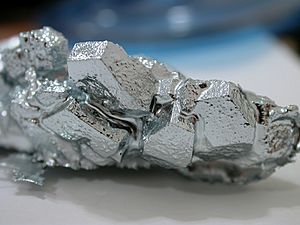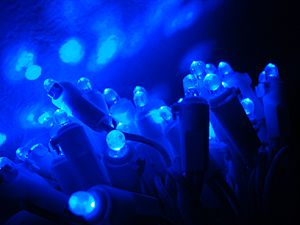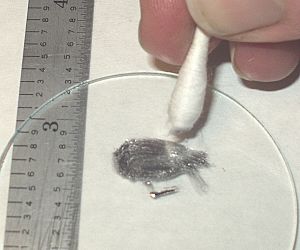Gallium facts for kids

Gallium (chemical symbol: Ga) is chemical element 31 on the periodic table.
Gallium is a metal, but is has some unusual properties. If it is held in a person's hand, it will melt. Gallium does not conduct electricity well, and is known as a semiconductor. That means gallium can be used in computers to make them work. It is very shiny, so it is used to paint mirrors when melted.
Very pure gallium has a stunning silvery color and its solid metal breaks easily like glass. Gallium metal expands by 3.1 percent when it solidifies, and therefore should not be stored in either glass or metal containers. Gallium also corrodes most other metals by diffusing into their metal lattice.
History
Gallium (Latin Gallia meaning Gaul; also gallus, meaning "rooster") was discovered spectroscopically by Lecoq de Boisbaudran in 1875. Before its discovery, most of its properties had been predicted and described by Dmitri Mendeleev (who called the hypothetical element eka-aluminium) on the basis of its position in his periodic table. Later, in 1875, Boisbaudran obtained the free metal through the electrolysis of its hydroxide in KOH solution. He named the element after his native land of France and, in one of those multilingual puns so beloved of men of science of the early 19th century, after himself, as 'Lecoq' = the rooster, and Latin for rooster is "gallus".
Applications
Analog integrated circuits are the most common application for gallium, with optoelectronic devices (mostly laser diodes and light-emitting diodes) as the second largest end use.
Other uses include:
- Since it wets glass or porcelain, gallium can be used to create brilliant mirrors.
- Used widely to dope semiconductors and produce solid-state devices like transistors.
- Gallium is used in some high temperature thermometers.
- Gallium readily alloys with most metals, and has been used as a component in low-melting alloys. The plutonium pits of nuclear weapons employ an alloy with gallium to stabilize the allotropes of plutonium. Much research is being devoted to gallium alloys as substitutes for mercury dental amalgams, but such compounds have yet to see wide acceptance. Gallium added in quantities up to 2% in common solders can aid wetting and flow characteristics.
- It has been suggested that a liquid Gallium-Tin alloy could be use to cool computer chips in place of water. As it conducts heat approximately 65 times better than water it makes a considerably better coolant.
- Gallium salts are used as radiocontrast agents in medical imaging. For these applications, a radioactive isotope such as 67Ga is used.
Occurrence
Gallium does not exist in pure form in nature, nor are gallium compounds a primary source of extraction. It is rather found and extracted from minerals and ores in the Earth's crust. Some flue dusts from burning coal have been shown to contain as much 1.5 percent gallium.
Precautions
While not considered toxic, the data about gallium is inconclusive. Some sources suggest that it may cause dermatitis from prolonged exposure; other tests have not caused a positive reaction.
Images for kids
-
Bauxite mine in Jamaica (1984)
-
Owing to their low melting points, gallium and its alloys can be shaped into various 3D forms using 3D printing and additive manufacturing
See also
 In Spanish: Galio para niños
In Spanish: Galio para niños







